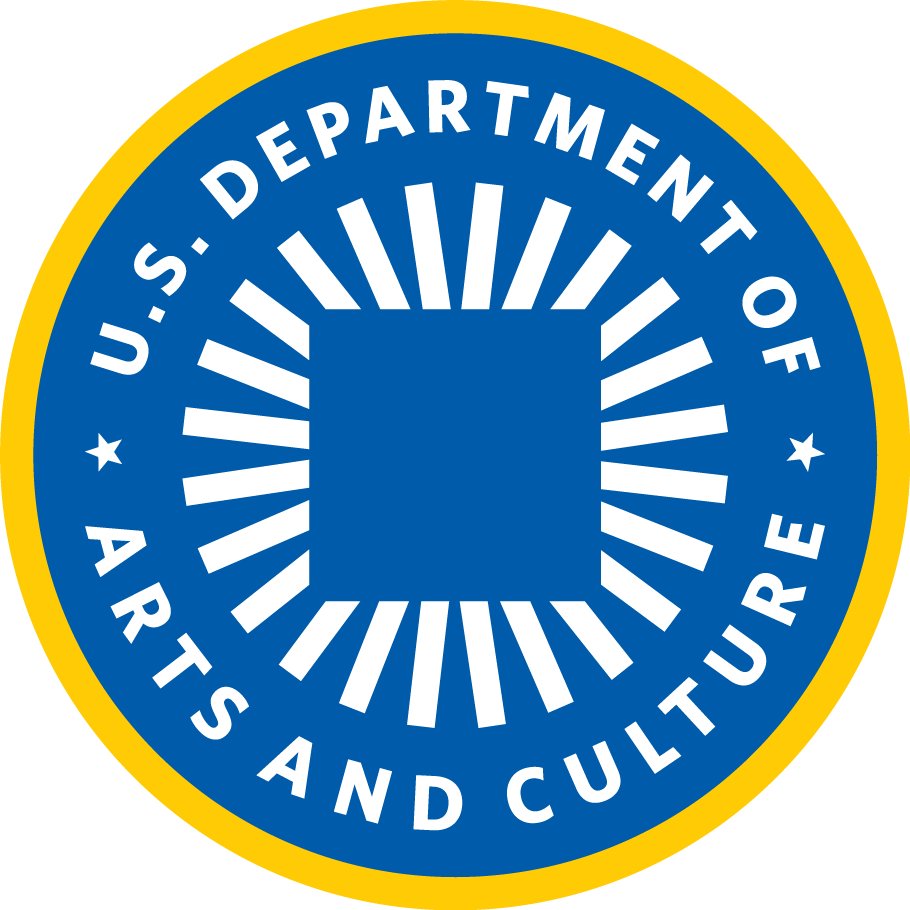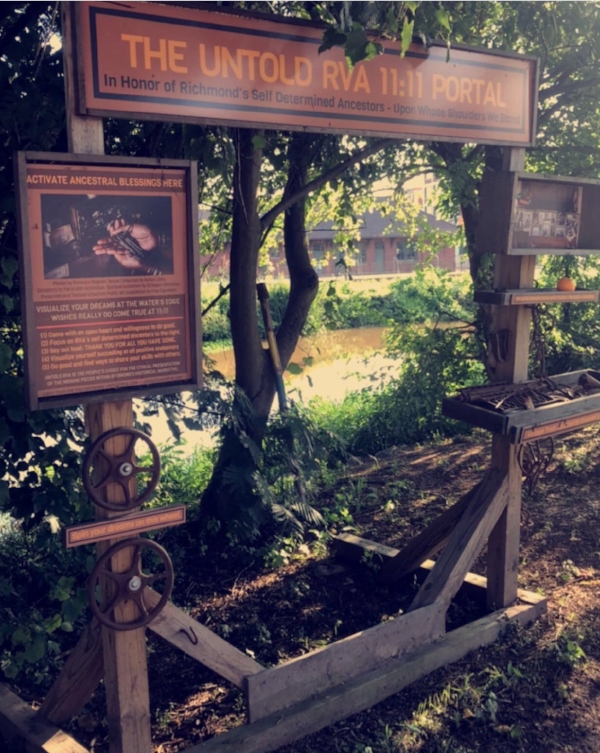by Arlene Goldbard, Chief Policy Wonk
This is the third in a series of blogs profiling the USDAC’s Policy Prototype projects, seven projects across the U.S. receiving micro-grants to document their work related to the proposals in “Standing for Cultural Democracy: The USDAC’s Policy and Action Platform.”
When Free Egunfemi proposed the STICK + MOVE project for one of the USDAC’s Policy Prototype micro-grants, she explained that the title refers to the “quick, nimble installation of breathtakingly illustrated wheatpaste collages to beautify the boarded-up windows and doors of the city's vacant properties…, inspiring communities by seeing people who look like them artfully represented in their neighborhoods with stunning visuals that correspond with fascinating lost historical narratives from the bygone era.” Speaking to Platform point 5— Invest in Belonging and Cultural Citizenship—Free, founder of Untold RVA and more recently, the Richmond, VA, USDAC Outpost, characterized this work as an alternative to expensive, time-consuming, and resource-intensive traditional monuments:
Untold RVA taps into the power of public history and public art via creative placemaking, tactical urbanism, public (street) art, public media, community design and archival activism as an innovative and cost-effective alternative.
Collaborating with media-maker Kelley Libby, Untold RVA set up Storefront Studio in a corner of the Six Points Innovation Center (6PIC, a “youth-led, youth-centered” space for creativity, collaboration, and social justice). Free and Kelley had worked together through Localore, an initiative of the Association for Independents in Radio; scroll down to episode nine on this page to see the resulting video, “May It Be So,” Free’s story of commemorating ancestors as portrayed by Kelley in 2016. Kelley has since moved on to work in public radio. Free renamed the space Untold RVA in January 2018.
Honoring ancestors interred during slavery times without proper burial has been a through-line in Free’s work for years, as this 2015 account attests. The memorial altar built on the African Ancestral Burial Ground site in Shockoe Bottom is an example of what Free calls “commemorative justice,” a powerful label for public arts and organizing work that corrects a biased record, one that often suppresses the stories of people of color and working people in favor of a whitewashed “great man” history. It’s hard work, subject to the same pressures that called it into being, as Free explained: “What Untold RVA is all about is being able to combat the erasure of important narratives within the commemorative landscape; and the fact that I'm combating erasure means that I'm susceptible to modern-day erasure of what I'm doing, including those who vandalize our installations.”
Untold RVA’s 11:11 Portal Project, an installation “dedicated to our community's Honored Ancestors whose achievements in Richmond continue to inspire us from the invisible realm of The Beloved Unseen.”
Kelley’s subsequent media project continued the exploration of buried history with UnMonumental. Each installment of this weekly radio series showed how community-driven local stories can challenge false history narratives, profiling Richmond residents including musicians, librarians and nonprofit leaders. The series’ logo was an image of the base of a fallen monument.
For the STICK + MOVE project, Free was able to buy software that turned the wheatpaste posters of under-recognized historic figures into interactive artworks. “With that software,” Free told me, “I was able to then upload up to 4,000 individual entries into a database which is accessible online by a person calling 804-277-8116.” People enter a numeric code that appears on one of the posters, and that allows them to access a relevant story. Enter 91# and you’ll hear James Gannon, a descendant of Confederate General Robert E. Lee and journalist for Al Jezeera, who visited Richmond in April as part of his coverage of work to see statues of his ancestor and other pro-slavery figures removed.
Last summer, in the first Keepers of the Light installation, STICK + MOVE wheatpaste posters illustrated by Barry O'Keefe were installed on the base of light poles in the area where a statue of Maggie Lena Walker was inaugurated before a crowd of 20,000. (Enter code #20 at 804-277-8116 to hear more.) Free described the impact of that project:
I found that STICK + MOVE works in a way that even a $1,000,000 statue—that took 20 years to get up, plenty of advocacy and fights out the wazoo, finally makes it to right in the middle of Broad Street in the middle of the city—can’t. There was no way for the information to get to the people about why she should be regarded as a celebrated businesswoman or celebrated mother. She was the very first female bank president in the United States and she was also black and she's from Richmond, Virginia.
With that project I got the support of the University of Richmond and their Race and Racism Archive. They had five students that were assigned specifically to Untold RVA. We set up a database with metadata. We put the installations at the bottom of the light posts. They stayed up for about a week and then suddenly the City came and power-washed them off.
But in the end, I wasn't really concerned. I noticed that once it got up and into social media, you can't power-wash social media. It was already in the National Parks Service’s press release. It was from their invitation that I translated the six phrases that were carved in the statue into something that would expand the narrative. It was already in the City press release that went all over the nation to announce the unveiling. But it was a little disappointing that they power-washed it without saying to me “Hey, what's up?”
Smaller STICK + MOVE installations were then created and posted at eye-level on light poles, and happily, those have stayed up. The project has become known and valued, says Free:
It's been an incremental progress for me to be recognized as a historian, a people's historian specifically, so that institutions began to engage. In large part because of me being able to reference being a Policy Prototype with the USDAC I began to get calls by universities across the country, especially locally. The Virginia Museum of Fine Arts; the Valentine, a museum specifically for Richmond commemoration; and then a brand-new architectural marvel, the Institute for Contemporary Art; the Dance Department and the Arc of Racial Justice Institute at the University of Richmond. It's like three or four times out of every week I'm somewhere talking about STICK + MOVE, talking about commemorative justice.
A wheatpaste installation from STICK + MOVE.
Free has advice for those who want to try a similar project in their own community:
Play your cards close to your chest and really make strategic alliances because it's easy to undermine people who are not attached to institutions and to neutralize these things, especially in cities where there's a lot of contention about the commemorative landscape. It really helps to be able to have an academic institution to partner with. If you have archival activists involved in your project then no one could ever refute the information that you're conveying with the hidden history. Get a memorandum of agreement with partners—they normally don't have to be run up the pole to their deans or anything. It can be the department chairs that do them on their own because they're not legally binding. It really is just speaking through the collaboration that they're asking for you to facilitate within their department. But it's still on letterhead, and it supports the establishment of that work, enabling that independent subject-matter expert to stand firm in what they know with their partners and their allies, to use that leverage.
Free reports that people “are just blown away by the ingenuity of utilizing crowd-sourced narration for these hidden historical gems. They really are excited about the opportunity to narrate one themselves.” Whenever she makes a presentation or leads a tour, she invites participants to use their cell phones to narrate and record one of her pre-written scripts about untold Richmond history. When the voiceovers are emailed to Free, she uploads them to her server and assigns each one a unique numerical code. All scripts include the same ending: “May this Untold RVA street art installation inspire generations. Power to the people! May it be so."
Untold RVA is a multidimensional project, with Untold Tours, Field Notes from the Front Line, COMMUNIVERSITY, and Untold Media all under its umbrella. The Untold RVA project unfolding right now, is “Gabriel Week,” 27 August-2 September 2018, “a citywide celebration of black innovation and commemorative justice inspired by Gabriel, Richmond’s own young warrior for black freedom.” (Gabriel Prosser, also known as General Gabriel, was the leader of a revolt by enslaved in Richmond in 1800.) Gabriel Week comprises a slew of events, parties, community design workshops, film screenings, a day in the park, even a history-based game, all in collaboration with many community and institutional partners. Richmond's mayor issued a proclamation for Gabriel Week: you can see it read on Facebook.
The Richmond commemorative justice agenda is large and long-term. Free explained that “Virginia generates seven billion dollars annually in heritage tourism! This is just heritage tourism, not whitewater rafting or anything else. And that's not even including the area in the capital city where all of the enslavement, dungeons, and auction blocks—there's 54 of them in Richmond that are unmarked that I've been marking. Seven billion dollars, and none of that is pointing to a tourism economy connected to enslavement and black history in the capital city. I recognize that there is a huge opportunity to be able to make sure that the people's voice gets in place within that and that it enables the descendant community to tell its own story. I’m doing all of this to hold space for that.”
And the work is being recognized. Untold RVA is part of the grant Richmond recently received in the Cities of Service City Hall AmeriCorps VISTA Love Your Block competition.
Free Egunfemi was named to the AIR Honor Roll for Localore programming about the work of Untold RVA.
If you’d like to explore bringing any points in Standing for Cultural Democracy to life in your community, please feel free to contact us at hello@usdac.us. While Policy Prototype micro-grants were a one-time thing, we can still offer technical assistance and help share information with the wider world, so call on us.



